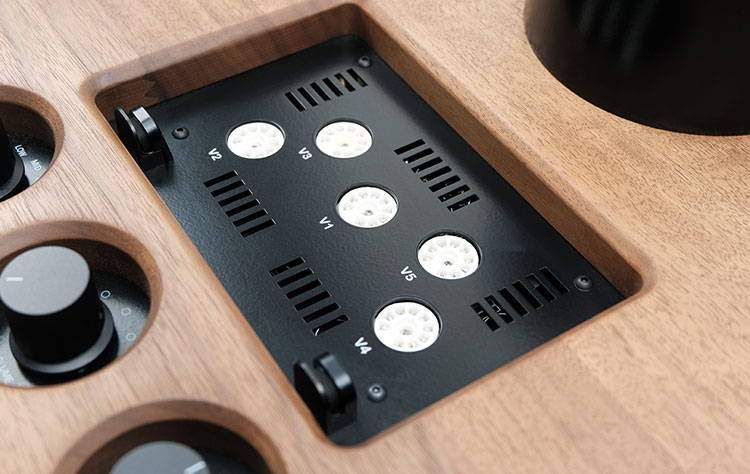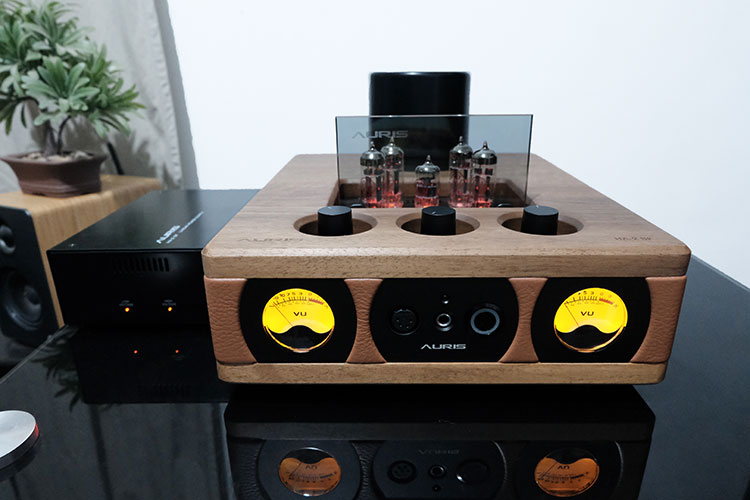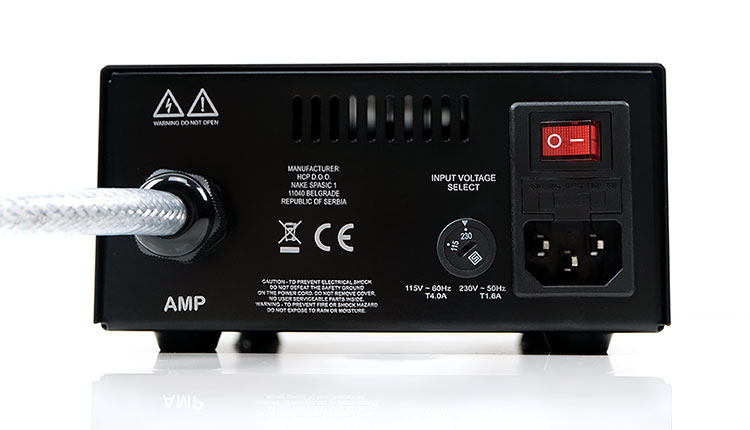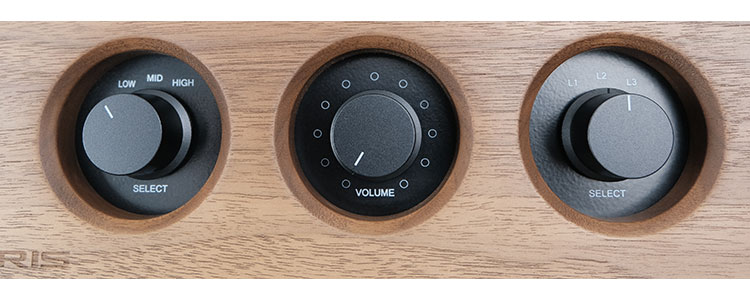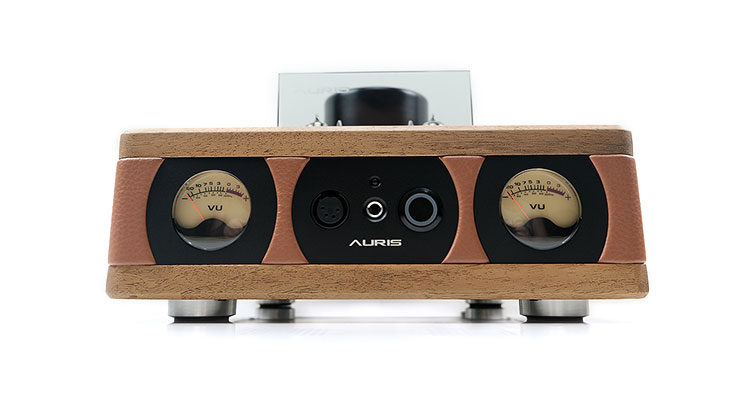The Auris Audio HA-2SF is the successor to the original HA-SE desktop tube amplifier with up to 2W of balanced output power. It is priced at $2499.
Disclaimer: The Auris Audio HA-2SF was sent to us in exchange for our honest opinion in this review. Many thanks to Auris Audio for giving us this opportunity.
You can read more about previous Auris Audio products reviewed or referenced on Headfonics here.
Note, this 2-page review follows our new scoring guidelines for 2021 which you can read up on here.
The HA-2SE has been a staple in the office here for the best part of nearly 3 years now, not just for its excellent sonic character but also its crazy good looks. Three years is quite some time in the fast-moving audiophile market so I was not terribly surprised when Auris Audio decided to offer an improved version.
The HA-2SF is indeed the successor to the HA-2SE and includes a whole host of changes. Some have been drawn from previous improvements such as a linear PSU that was first seen in their headphone amplifier product range with the Euterpe and the Nirvana.
Others from customer feedback and market demands such as improved output power, balanced connections, and some rather cool VU displays to go along with a snazzy updated design.
Considering the upgrades the price point of the HA-2SF has remained relatively unchanged at $2499 or around €2050 which in fact might be slightly cheaper than the listed SRP we had on the HA-2SE price from 2017. How lovely is that then?
Tech Highlights
Tube Configuration
The HA-2SF is an analog SET headphone amplifier with preamp output. It has a top-loaded tube configuration of four JJ Electronics ECC99 9-pin double triode power tubes and a single input JJ Electronics ECC82 tube. The ECC82 is a 12AU7 medium gain pre-amplifying double triode design.
The stock tubes are not the gold pin varieties so far as I am aware and have an average lifecycle of around 3000 hours each. The ECC99 driver tubes are generally recognized as having excellent current handling capability and should be good for planar driver synergy.
The ECC82 adds some flavor and is known for good quality detail retrieval, not overly buttery sounding, as well as offering some excellent headroom. Rolling should be a lot easier than the previous HA-2SE configuration of PL95/EL95’s given the ECC82’s are part of the 12AU7 family as well as the fact there is no PL/EL switch to the rear of the HA-2SF anymore to be aware of.
Replacements should also be fairly easy to acquire. Stock JJ Electronics ECC99 tubes will cost you around $15 per tube or $30 for the gold pin variety but we do advise getting matched quads for the ECC99 if possible.
Amplification Design
Beyond the tube configuration, the SET amplifier inside is a single-ended pure Class A bias which might throw you considering it offers balanced input and output connectors. Yes, this is still an SE topology but with balanced connectors for a wider choice much like the Xi Audio Formula S flagship amplifier.
The performance numbers do seem to be a setup on the original HA-2SE which I classed as moderate at 1W into 32Ω. Now we have basically double the output power from both the balanced and SE outputs at 2W into the same load.
This should give an enhanced level of dynamic range and headroom for modern planars though it still might be considered on the low-end of output power for the really demanding stuff like the Susvara and Abyss planars.
Still, popular headphones such as the Empyrean, Final D8000 Series, and most Audeze planars should benefit from the better current drive from the new power tube configuration.
Impedance Matching
Impedance matching has changed slightly also on the HA-2SF though the desired range of 32Ω to 600Ω from the selector switch should be able to accommodate most dynamic driver headphones.
The numbers are not specific to an impedance value like on the back of the older HA-2SE. Instead, the HA-2SF has a low, medium, and high impedance selector switch (with a constant maximum 2W output at each selection), so you will have to play it by ear. Suffice to say high for the likes of Sennheiser’s HD600/650 and low for 50Ω headphones and below.
Some eagle-eyes shoppers might note that this particular sample has a low/high gain switch to the rear whereas the initial production batch did not. This seems to be an additional function-creep for the current production version and for many, a welcome bonus.
Design
Materials
What a ridiculously desirable design, perhaps even more so than the original HA-2SE. The HA-2SF takes everything great about the original mix of stylish wood and leathers and ’70s’ it with a dash of faded tans and a lighter wood grain for the exterior.
The sample we have here is officially called the ‘brown’ edition but for those loyal to the dark grain and black leather of the HA-2SE, you can also opt to buy a similar finish for the HA-2SF from their website. For those who liked the older white edition, sorry but you are out of luck as the new HA-2SF does not have a white option.
For first-time readers, this is a solid-wood finish and not a cheap panel variant. Knock on the wood sides or top and you will get a reassuring solid tone without any worrying hollow echoes rebounding back at you.
The leather central wrap is real vintage leather also finished with a nice authentic ‘rough’ surface all the way around the sides and around the controls to the front of the panel. The back is still a black metal finish but given this is where a lot of the internal heat is vented that is not surprising.
In place of the woody grill protecting the tubes on the top panel you now have a replaceable smoked glass panel with the Auris branding top left. These are held by two clamps at the base which can be adjusted. This should give you better access to tight spots around the tubes for cleaning and rolling.
Form Factor
Although the weight of both remains at 9kg, the HA-2SF form factor has changed from the original. The height of the unit has got a welcome drop from 230mm to just 74mm. I always felt the original was a bit too tall for standard HiFi racks so it is quite pleasing the HA-2SF now fits neatly in the Sabre racks in the office.
Part of the slimline change is the housing dimensions themselves which are now slimmer but longer than the original. However, another reason is the change from long spiked feet with detachable stoppers to thicker but shorter all-in-one steel columns with rubber feet.
I loved the aesthetics of the spiked stands but they were quite tricky to manage for lifting and placing them down again. Given how sharp the points are you could do damage to your shelf surface if you didn’t ‘nail the landing’ so to speak. The new feet are not only safer but feel better equipped to prevent unintended movement.
Since the power button is also on the front panel on the HA-2SF there is also no need to have that additional space underneath to be able to safely reach the button with your fingers.
Let There Be Light!
The HA-S2SF is a visual feast of illumination with bright operational VU displays to the left and right, an LED underlit tube bay that adds a little bit of glitz to the existing tube glows not to mention some additional diode lighting from the external PSU.
Granted, this is a bit of a nightmare if you plan on some listening in low-lighting conditions but I think the visual pop is quite attractive and interesting. Perhaps a suggestion that any 3rd gen amplifier can have a control switch to turn various aspects on and off so we can have the best of both worlds?
Those are real passive logarithmic VU-meters by the way so they will respond to the varying degrees of power that is being provided from the amp to the headphones. These ones seem sensitive enough when used with our test headphones so you will see some movement depending on the load and dynamic range of the audio signal.
External PSU
Consistent with the Euterpe and their higher-end amplifiers, Auris Audio has also upgraded the HA-2SF with an external aluminum housed linear power supply. This particular black finished unit is a little bit beefier than the one supplied with the Euterpe weighing in at 3Kg and comes standard now on all their higher-end models.
Unlike the Euterpe PSU, this particular design comes with a 4-pin connector cable that is detachable at both ends so if anything happens you can swap it out for replacement or roll with another cable depending on your preferences.
The design does have a variable 115V to 230V voltage selector also to the rear just underneath a read ventilation system which keeps everything relatively cool during operation. To the front, you get two LED indicators for low and high-voltage operation as well as some additional venting to the top.
I/O
To the front, the HA-2SF is adorned with two headphone outputs, a 6.35mm SE and a 4pin XLR socket with a slightly recessed plastic power on/off button to the right of the SE socket.
Now, bear in mind this is an SE topology so this is more about choice than the provision of a dual-circuit amplification topology. Visual IO is also provided on the extreme left and right with those VU meters covering the left and right channels independently.
On the rear, you get 3 dual-RCA connections as you did before but this time one of them is a dedicated pre-out should you wish to use the HA-2SE in a preamp configuration to a power amplifier which the HA-SE did not offer. The other two dual-RCA connections work in the same manner previously for a source or another pre-amp input and have a rated sensitivity of 1Vrms.
The final input or should we say the first one as they are coded 1, 2, and 3, is a set of balanced 3-pin XLR connectors. They work in the same manner as the dual-RCA but will allow you to jack from sources with balanced outputs that can often deliver a stronger Vrms input than going SE to SE.
The remaining I/O includes a gain switch (high and low) which is now standard on all but the initial production run of the HA-2SF and offers up to an additional 30dB of gain. To the extreme right, you have the 4-pin power socket for connecting the external PSU.
Controls
The previous impedance selector has now moved to the top panel alongside the volume and input selectors. The power button has also moved from the base of the chassis to the front panel with the soft blue diode of the HA-2SE now gone.
The volume pot I am fairly sure is the same one used on the original HA-2SE which is an ALPS potentiometer. The pot articulation felt smooth, with decent resistance, and released a fairly steady increase in current with most headphones.
The impedance selector will give you three options now so instead of 4 dedicated resistance points you now get low, medium, and high and a range of 32Ω to 600Ω. That does mean a bit of trial and error when it comes to the best setting and you can read more about what we thought about the settings in more detail on page 2.
Remote Control
The HA-2SF is also remote control capable but it is an optional purchase at a fairly lofty additional €100. Luckily the previous HA-2SE review unit we had here came with remote control and I can confirm that its remote works just fine with the new unit. That also means I can rather handily control the volume of both at the exact same time when A/B’ing.
The control itself is solid metal with pre-supplied blister feet on the base which honestly I wish more companies would offer, particularly if you use HiFi tempered glass racks such as we do.
The control is for volume only in terms of plus or minus with a mute button. You do not have to point it directly at the top panel to get a reliable level of control though the movement is not as refined as using your fingers manually.
Packaging & Accessories
Auris Audio packaging is always elaborate and incredibly well protected for courier long hauls. Not only is the amp and PSU foam packaged on the inside with separate cubby holes for the tubes and accompanying accessories but externally you get not one, but two boxes with an additional layer of clingfilm protective wrapping.
The box is finished with stiff plastic corner plates just underneath the film wrap to stiffen up the entire package even more. It does take quite a long time to unwrap this and I am not 100% sure all of it is recyclable but I would advise you to retain the corner plates and external boxes in case you need to move around because they do a hell of a job keeping the amp quite safe.
Aside from the optional remote control, you will also receive a power cable terminated with your country-preferred plug and a useful owner’s manual.
The tubes are easily sorted out being numbered V1-V5 on the outside of their individual retail boxes which also precisely matches the labeled tube sockets on the amplifier itself.
Sound Impressions
(Tested with a Chord Qutest DAC, Musician Audio R2R DAC, Meze Empyrean, T+A Solitaire P, Final Audio D8000 Pro, and Audeze LCD-2 Closed)
Summary
We will compare both the HA-2SE and HA-2SF in more detail in our comparison section but I wanted to just start the whole summary with just how much more vivid and resolving the new version is over the old.
This is still a SET sound for me so not quite as dry or energetic as a TOTL solid-state but equally nothing ‘vintage’, being neither overly soft nor relaxed in its delivery. This is a natural to slightly analog overtone imbued with impressive clarity and articulation right across the FR from almost every headphone we tested it with.
This time, instead of a slightly mid-focused presentation from the original you get a more balanced and punchy performance. That means a more distinct and powerful low-end with better definition right down to sub-bass growls, a faster transient response with less distortion, and a more spacious staging quality with improved headroom.
And that benefits the midrange presence with a more open quality to its imaging and a lot more space from instrument to vocal than on the previous incarnation. I would still say vocals have a little bit of a lift though how much of a lift is ultimately going to be determined by both your DAC and headphone’s own sonic characteristics.
That lift though is not in your face to the expense of everything around it. Contextually, the HA-2SF does create a slightly more balanced midrange in comparison to the HA-2SE which tended to place the mids above everything else.
A big factor in that is the better treble clarity shining through from those newly select ECC tubes. They do an excellent job stretching the staging quality which, combined with the improved dynamic range and power, offers a substantially improved holographic quality of the HA-2SF.
Timbre
The HA-2SF pulls back on the more obvious warmth and softness of its predecessor instead offering a more balanced and powerful sounding timbre. However, it still sounds relatively analog and ‘wet’ to me when pitted against solid-state competitors.
Treble presence has improved considerably as well as sub-bass presence and power. Instrumental notes have a much stronger bass fundamental this time around but properly countered with a better odd-harmonic influence to prevent them from sounding dull and overly-rounded.
Whilst this seems to be a core timbral trait, that of a natural but robust quality to instruments and vocals, you do have to be careful with your source and impedance matching. There is enough transparency in the HA-2SF’s output for each to have an impact ranging from nuanced to obvious.
For example, paired with the Chord Qutest DAC the HA-2SF timbre is pure as in ‘Hi-Fidelity’ through the mids and treble with an excellent instrumental harmonic balance. Nothing is sharp or edgy sounding, vocals are clear and natural in tone without any emphasized sibilance, and the bass is dynamic and punchy. You will not hear too much softness with this combo.
On the flip side, the Musician Audio Pegasus R2R DAC injects a bit more warmth into the HA-2SF’s timbre, smoothing out the more dynamic character of the Qutest, and bringing forward the lower mids a bit more.
With this combo, the vocal texture has a bit more detail with less ‘shine’ in the amplifier’s treble delivery. Overall, a sound that’s better on textured detail but with a more rounded timbral quality.
Staging
This is where the HA-2SF has been significantly upgraded over the original. The dynamic range improvement is obvious with a punchier better extended low-end, enhanced sub-bass definition and rumble, and a cleaner more extended treble presence.
The mids still have great presence, vocals slightly to the fore but this time the staging dimension is wider, more spacious, and open sounding. Vocals now have more space to breathe. Imaging is more refined with higher-pitching spatial cues benefitting from a slightly cleaner tone to give them a bit of lift and making them easier to pick up.
Instrumental separation is more 3-dimensional this time around, perhaps due to the lift in the bass and treble presence adding a bit of welcome air on both ends of the scale. Certainly, the softness present in the original has been done away with and a slightly shorter decay introduced that helps tighten up the performance.
I still would not go as far as to say it has the same ethereal quality to its top-end compared to the Formula S from Xi Audio, nor as bright and sparkling as the Studio 6 from ALO Audio but the headroom has definitely improved.
Click on page 2 below for synergy and select comparisons



